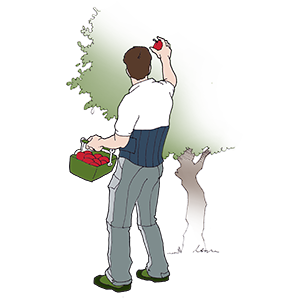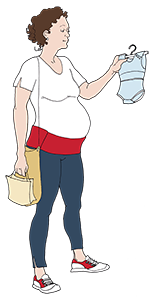Orthoses for the Back
Last updated 21-05-2025 If you have back problems, for example in the nature of pain, lack of strength, or an asymmetric back, you may benefit from a supportive orthosis. This guide provides an overview of different types of orthoses, e.g. corsets and bandages, as well as an insight into the various applications.
If you have back problems, for example in the nature of pain, lack of strength, or an asymmetric back, you may benefit from a supportive orthosis. This guide provides an overview of different types of orthoses, e.g. corsets and bandages, as well as an insight into the various applications.Orthoses for the back back are designed to support or stabilize the bones, joints, and muscles of the back and are subdivided according to the structure of the spine: the pelvis (the sacro-iliac part), the lower back (the lumbar part), the middle part of the back (the thoracic part), and the neck (the cervical part).
Will this be relevant for you?
If, for example, you have neck pain, an asymmetric back, an unstable lower back, or an unstable pelvis or if you need support when lifting heavy objects, a back orthosis may be relevant.
In general, orthoses for the back can be used to
- support or stabilize the body
- reduce the consequences of a deformity
- prevent movement of an area (e.g. in case of hypermobility)
- improve functions
- relieve pain
- promote healing and protect tissue
- support other effects (e.g. support a desired movement pattern, a desired posture, or provide heat).
It can be difficult for yourself to assess whether an orthosis for the back is relevant to use, as well as which type you need and how to use it.
Your physician, an orthoptist, or an occupational or physiotherapist can provide professional guidance.
What types are there?
Back orthoses can be custom-made to meet individual needs or manufactured in standard measurements and shapes with or without customization options. In the following, different types of orthoses for the back will be described.
Pelvic belts
A pelvic belt sacro-iliac orthoses is a wide, adjustable and more or less elastic belt for use around the waist and is designed to provide support for the pelvis.
If you use a pelvic belt, it helps stabilizing the joints when you move. In this way, you do not put as much strain on the joints, and any pain is reduced.
A pelvic belt can provide extra support for heavy lifting. For people who need support for the abdomen, e.g. due to overweight or pregnancy, a pelvic belt can also be useful.
If you have symphysis pubis dysfunction (SPD), a pelvic belt may be relevant. A physiotherapist can show you relevant exercises and tell you if there are movements you should avoid.
Lumbar and back corsets
Lumbar corsets (lumbo-sacral orthoses) and back corsets (thoraco-lumbo-sacral orthoses), e.g. elastic soft corsets or fabric support corsets can be used to relieve the back. It may be relevant for reduced stability in the lower back, asymmetric back, or pain in the lower back or back.
Corsets consist of elastic and/or non-elastic parts. They can have an elastic effect either lengthwise or transversely. There may also be stiffening parts in the corset that limit the possibilities of movement.
Support corsets for the abdomen
A support corset for the abdomen kcan relieve a weakened or overloaded abdominal wall. Most of these corsets close with Velcro, so that the corset can be adapted to your individual needs. Some corsets are made of an elastic material that adapts to your body shape, others are of a firmer material. There are also corsets that are equipped with flexible braces, that stabilize even further. For people with a stoma, there are special corsets designed with a hole for the ostomy bag.
After a hernia operation, in some cases it may be necessary to use soft corsets. You can find examples of this type of corset under abdominal hernia aids.
Neck collars and neck bandages
If you have had a whiplash, a neck collar or neck bandage (cervical orthosis) may relieve you or relieve the pain. There are neck collars that go all the way around the neck and others that are open at the front with a supportive brace.
When using a neck collar or neck bandage, please be aware that it reduces your mobility, which can be inappropriate as it increases the risk of building up tension. At other times, however, the restriction of movement can relieve you. It is important that the pain does not get worse when using the neck collar.
How to get started
It is generally a good idea to have a physician, an occupational therapist or a physiotherapist advise you on how to use a back orthosis. Among other things, a professional can help you assess how many hours per day to use the orthosis.
It is important that an orthosis for the back provides the necessary support, neither more nor less.
A back orthosis should have a positive effect on your level of function. Among other things, you must be aware if the orthosis inhibits movement of the back, preventing you, e.g. in walking your usual distance or carrying out you usual activities.
You should aim to walk and move as naturally as possible when using a back orthosis. You must continue to walk swinging your arms and a slight rotation in the upper body. Continued use and training of your abdominal and back muscles will help ensure that you do not lose muscle strength.
When using the orthosis, you must be aware that it is not too tight, hurts, or in other ways bothers you. If you get bruises on your skin, chafing or pressure sores, the orthosis is either too tight, too loose, or it is not properly adjusted to you. It is important that you react to any discomfort, including pain. Your physician, an occupational therapist, a physiotherapist or an orthotist can help you find out the cause of the discomfort and help you further in terms of using the orthosis.
Cleaning and maintenance
Please always follow the suppliers instructions regarding cleaning and maintenance of your assistive product.
Most orthoses to support the back can be machine washed. First close any Velcro, and wash the aid in a washing bag – this prolongs the life of the Velcro.
Safety
Orthoses for the back must meet a number of requirements in relation to strength and materials, and the manufacturer must be able to document that they serve the purpose for which they are marketed. These requirements appear, e.g. in the standards:


